Research on intelligent steering of passenger cars: The development of intelligent steering is accelerating, and it will be put on vehicles in batches in 2023
- In September 2022, Geely and Hella jointly developed a series production-ready steer-by-wire (SBW) system which will be spawned from 2026.
- In October 2022, NIO signed a strategic cooperation agreement with ZF. They will work together in the development of SBW products.
- Toyota bZ4X featuring JTEKT 's SBW technology was put into mass production and launched in October 2022.
- Schaeffler Technologies AG & Co. KG and Arnold Verwaltungs GmbH signed a basic agreement under which Schaeffler Technologies AG & Co. KG will acquire the remaining 10% stake in the joint venture company Schaeffler Paravan Technologie GmbH & Co. KG (Schaeffler Paravan) from Arnold Verwaltungs GmbH. Schaeffler’s objective is to accelerate the development of integrated SBW systems for large-series automotive production, and also to use the market access gained through Space Drive applications to market fully developed volume production solutions.
……
From the perspective of supply and demand, the above-mentioned phenomena indicate that intelligent steering systems (including SBW systems) will gradually enter the consumer market. In 2023, the era of traditional mechanical connection will come to an end, while the SBW age may begin.
SBW systems will gradually replace electronic power steering systems.
With the development of intelligence, automotive chassis is evolving from traditional chassis to chassis-by-wire. For the sake of more accurate actuation, faster response and higher safety, high-level intelligent driving or autonomous vehicles require chassis systems to cancel the mechanical connection between actuators as much as possible, and use electrical signals to transmit instructions instead. At the same time, the system reliability and security should be ensured by additional redundant electronic components.
At present, electronic power steering (EPS) systems are the most advanced steering system solution for mass production. The fundamental difference between SBW and EPS is that the former removes mechanical connection between steering wheel and steering rod, and completely decouples steering wheel and steering mechanism. After being widely used in high-level intelligent driving in the future, SBW can avoid interference with the driver's steering action and possible collision when the vehicle automatically turns in an emergency under control of ECU. Without a physical structure, SBW helps improve vehicle performance in terms of lightweight, responsiveness, and cockpit layout.
In chassis-by-wire, a SBW system is the core component that controls the lateral movement, and also one of important actuators of high-level intelligent driving. At present, SBW systems are still in the technical verification stage, let alone mass production. However, the absence of mechanical redundancy puts forward higher requirements for the reliability of electronic equipment and systems. Before high-level autonomous driving is popular, there are still many challenges for the development of SBW. At present, EPS is still the mainstream of market, but SBW with smaller size and higher security will embody the future trend.
With the development of high-level autonomous driving and the synchronization of "electrification, intelligence, software and sharing", the intelligent steering of passenger cars presents the following development trends:
Trend 1: Steering systems gradually evolve
As the core part of chassis, steering systems have gone through many mutations, such as mechanical steering systems, hydraulic power steering (HPS) systems, electric power steering (EPS) systems, redundant steering systems (RSS), steer-by-wire (SBW) systems, etc., gradually transforming from mechanization to electrification, then to intelligence. The operating performance of steering systems has been improved, with higher levels of integration, electrification and intelligence. As the penetration rate of autonomous driving increases, the evolution to SBW systems will accelerate, and the upgrade of steering systems will match the level of autonomous driving.
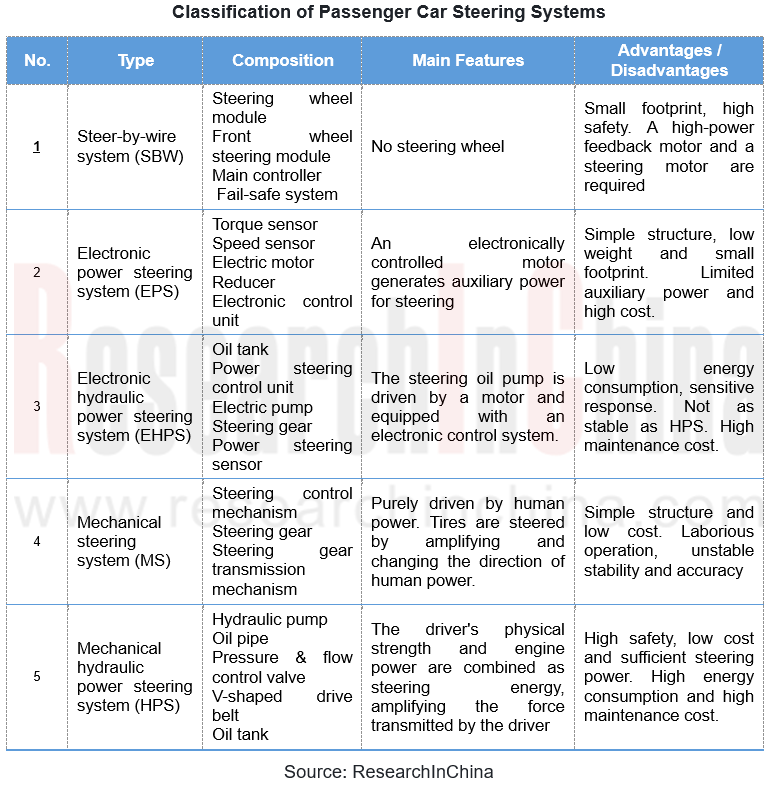
Trend 2: From electric control steering, redundant steering to SBW
Amid the electrification of vehicles, intelligence has become a new driving force for the development of steering technology. In response to the requirements of autonomous driving, steering systems should feature higher safety and reliability to ensure that vehicles can enter a safe state or even continue to run safely when electrical systems fail. Therefore, the industry is studying new technologies such as redundant EPS and SBW to guarantee system safety. Compared with redundant EPS, the most notable feature of SBW lies in zero mechanical connection between the steering wheel and the actuator, which brings about obvious advantages in cost control, design flexibility, functional richness and space layout.
As the core role of intelligent chassis, steering systems have high technical barriers. At present, German, American, Japanese and Korean steering giants still dominate the steering system market, especially redundant EPS and SBW segments. China is catching up with them. With the gradual maturity of China's intelligent automotive industry chain, some enterprises have mastered the core technology of steering systems and even SBW. They are expected to break the technical barriers and quickly seize the market share in the future.
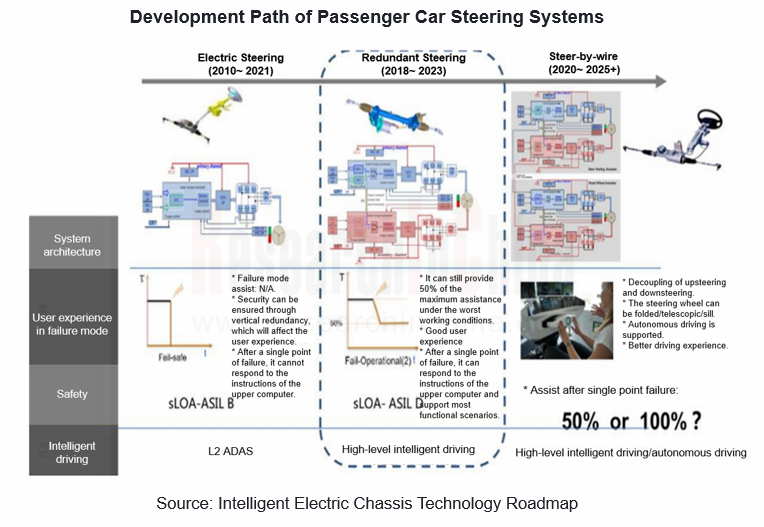
Trend 3: SBW has not seen mass production, but domestic and foreign automakers and suppliers are deploying SBW vigorously
Toyota bZ4X has once again introduced the SBW technology to automotive market, providing the first experience for the mass production and application of SBW. It may make a major breakthrough in the development of SBW technology. Tesla aims to start mass production of its eagerly anticipated all-electric pickup truck “Cybertruck” in late 2023. Great Wall Motor's next-generation smart chassis also adopts SBW technology and it plans to start mass production in 2023. SBW will be verified by the market extensively.
At present, neither international nor local vendors have realized mass production of SBW technology. Amid high R&D investment by local enterprises, the vendors with leading positions in EPS and technology accumulation will perform better in SBW technology, and may surpass international counterparts soon.
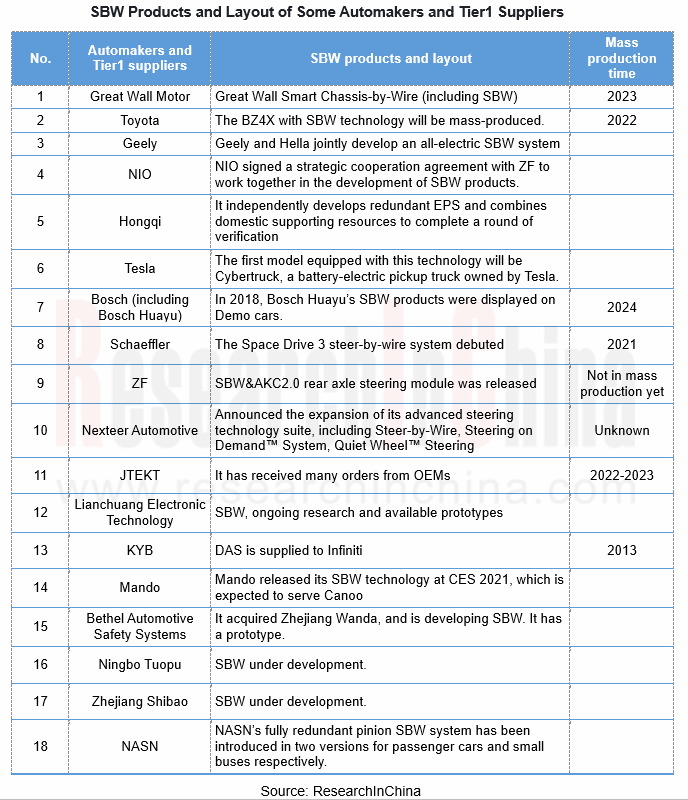
Trend 4: 2023 may become the first year of mass production of SBW
Toyota will launch bZ4X equipped with a SBW system in European market. This system has an additional standby power supply module, which improves the stability and diversity of system power supply with lithium batteries and capacitors based on a traditional generator and 12V power supply. In order to ensure reliability and safety of steering system, bZ4X has added electronic redundancy to power supply, communication bus, torque sensor, motor angle sensor, microprocessor, power drive and motor coil. Toyota bZ4X has once again introduced SBW technology to automotive market, providing the first experience for the mass production and application of SBW. It may make a major breakthrough in the development of SBW technology. The technical achievements of SBW have taken shape, and mass production may start in 2023.
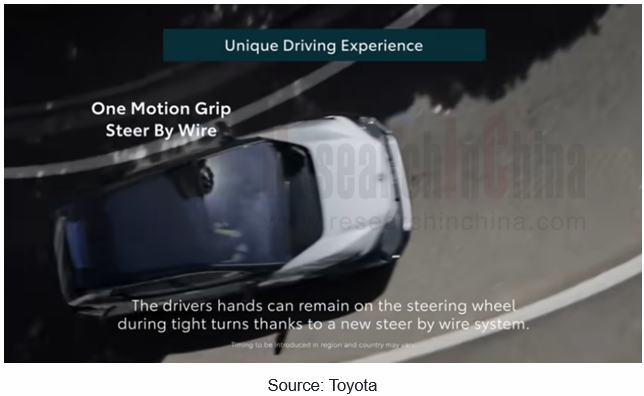
Trend 5: SBW highlights convenience
Without a steering column, SBW can prevent driver from being injured by steering column in an accident. When the driver is driving, SBW ECU can judge whether the driver's operation is reasonable according to the driving state, and make certain adjustments to improve driving stability and safety. At present, different models are equipped with different steering systems, which cannot fit all.
Due to mechanical decoupling and flexible space layout, SBW can be applied to different models, assisting the development of chassis integration and reducing the OEM production cost. The SBW system abolishes the intermediate mechanical shaft for connection in the traditional steering system, allows the ECU to handle steering actively, and keeps the steering wheel still during the steering process, which facilitates high-level intelligent driving and facilitates the driver to take over. The traditional steering system adopts mechanical connection with a fixed steering ratio, so that steering is determined by mechanical structures such as gears.
SBW has no mechanical connection, so the steering ratio can be adjusted at any time by software and the transmission ratio varies with the speed. After the steering column is removed, the space under the steering wheel becomes bigger, which makes the driver's legs have more room for movement with more freedom and convenience.
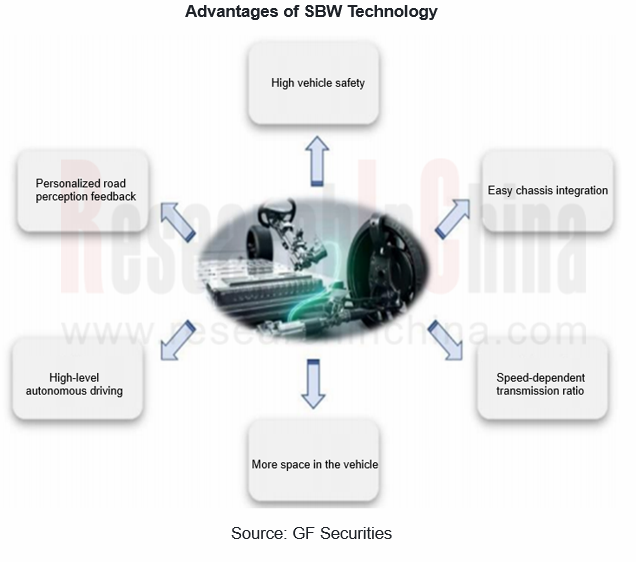
Trend 6: The development goals and technology route of SBW systems
According to Intelligent Electric Chassis Technology Roadmap released by Wire Control Working Group of China Industry Technology Innovation Strategic Alliance for Electric Vehicle (CAEV) in 2022, the development goals of passenger car SBW are shown in the following figure:
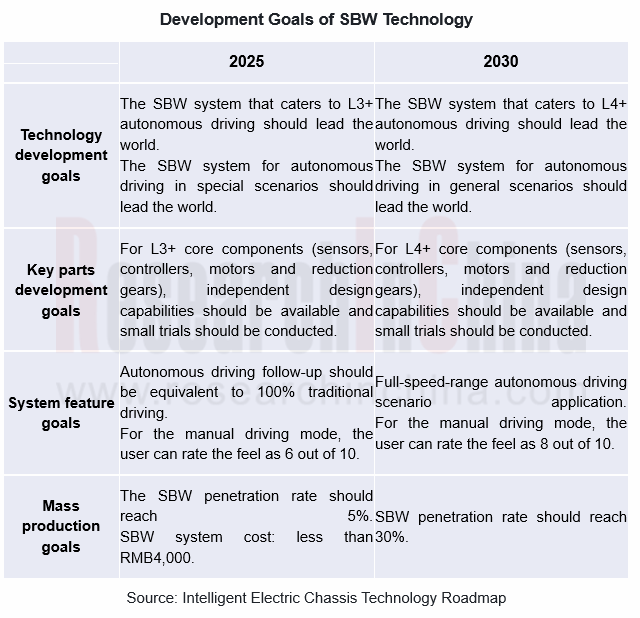
Goals in 2025: The SBW system that caters to L3+ autonomous driving should lead the world. For L3+ core components, independent design capabilities should be available and small trials should be conducted. The SBW penetration rate should reach 5%.
Goals in 2030: The SBW system that caters to L4+ autonomous driving should lead the world. For L4+ core components, independent design capabilities should be available and small trials should be conducted. The SBW penetration rate should reach 30%.
The intelligent steering technology for passenger cars mainly follows the route:
 In 2022, SBW should vary with the speed with a variable transmission ratio.
In 2022, SBW should vary with the speed with a variable transmission ratio.
 In 2023, functional safety should realize security network and safe development.
In 2023, functional safety should realize security network and safe development.
 In 2024, advanced functions should support highway assistance and traffic congestion assistance, and the mass production of rear wheel SBW should begin.
In 2024, advanced functions should support highway assistance and traffic congestion assistance, and the mass production of rear wheel SBW should begin.
 In 2025, front wheel SBW should be mass-produced with dual redundant controllers (10fit) and the coordinated control of steering and braking.
In 2025, front wheel SBW should be mass-produced with dual redundant controllers (10fit) and the coordinated control of steering and braking.
 In 2028, autonomous driving should bolster self-learning, personalized software and FOTA updates.
In 2028, autonomous driving should bolster self-learning, personalized software and FOTA updates.
 In 2030, intelligent chassis should feature SBW, brake-by-wire and suspension-by-wire to realize three-way coordinated control.
In 2030, intelligent chassis should feature SBW, brake-by-wire and suspension-by-wire to realize three-way coordinated control.
Passenger Car Intelligent Steering Industry Report, 2023
Passenger Car Intelligent Steering Industry Report, 2023 released by ResearchInChina combs through and studies the status quo of passenger car intelligent steering and the product layout of OEMs, supp...
Automotive High-precision Positioning Research Report, 2023-2024
Autonomous driving is rapidly advancing from highway NOA to urban NOA, and poses ever higher technical requirements for high-precision positioning, highlighting the following:
1. Higher accuracy: urb...
New Energy Vehicle Thermal Management System Research Report, 2023
Thermal management system research: the mass production of CO? heat pumps, integrated controllers and other innovative products accelerates
Thermal management of new energy vehicles coordinates the c...
Commercial Vehicle Intelligent Chassis Industry Report, 2023
Commercial Vehicle Intelligent Chassis Industry Report, 2023, released by ResearchInChina, combs through and researches status quo and related product layout of OEMs and suppliers, and predicts future...
Chinese Independent OEMs’ ADAS and Autonomous Driving Report, 2023
1. Wide adoption of NOA begins, and local brands grab market share.
According to ResearchInChina, from January to August 2023, joint venture brands accounted for 3.0% of installations of L2.5 and hi...
Passenger Car Radar Industry, 2022-2023
Passenger Car Radar Industry Research in 2023:?In 2023, over 20 million radars were installed, a year-on-year jump of 35%;?Driven by multiple factors such as driving-parking integration, NOA and L3, 5...
Automotive Audio System Industry Report, 2023
Technology development: personalized sound field technology iteration accelerates
From automotive radio to “host + amplifier + speaker + AVAS” mode, automotive audio system has passed through several...
China Intelligent Door Market Research Report, 2023
China Intelligent Door Market Research Report, 2023 released by ResearchInChina analyzes and studies the features, market status, OEMs’ layout, suppliers’ layout, and development trends of intelligent...
Automotive Infrared Night Vision System Research Report, 2023
According to the data from ResearchInChina, during 2022-2023, the installations of NVS (night vision system) in new passenger cars in China went up at first and then down. From January to July 2022, t...
New Energy Vehicle Electric Drive and Power Domain Industry Report, 2023
Electric drive and power domain research: electric drive assembly evolves to integration and domain control
To follow the development trend for electrified and lightweight vehicles, new energy vehic...
Automotive Software Business Models and Suppliers’ Layout Research Report, 2023
From the layout of automotive software products and solutions, it can be seen that intelligent vehicle software business models include IP, solutions and technical services, which are mainly charged i...
Automotive LiDAR Industry Report, 2023
In August 2021, Waymo discontinued its commercial LiDAR business.
In October 2022, Ibeo declared bankruptcy; in November, two listed companies, Velodyne and Ouster, confirmed their merger; and in Dec...
Automotive Power Supply (OBC+DC/DC+PDU) and Integrated Circuits (IC) Industry Report, 2023
Automotive power supply and IC: Chinese chips are promising in the evolution from physical integration to system integration
As the core component of a new energy vehicle, automotive power supply is ...
OEMs’ Model Planning Research Report, 2023-2025
OEMs’ Model Planning Research Report, 2023-2025, released by ResearchInChina, combs through model planning and features of Chinese independent brands, emerging carmakers, and joint venture brands in t...
Leading Foreign OEMs’ADAS and Autonomous Driving Report, 2023
Global automakers evolve to software-defined vehicles by upgrading EEAs.
Centralized electronic/electrical architectures (EEA) act as the hardware foundation to realize software-defined vehicles. At ...
Automotive AI Algorithm and Foundation Model Application Research Report, 2023
Large AI model research: NOA and foundation model facilitate a disruption in the ADAS industry.
Recently some events upset OEMs and small- and medium-sized ADAS companies, as the autonomous driving i...
Intelligent Cockpit Domain Controller and SoC Market Analysis Report, 2023Q2
Cockpit domain controller and chip in 2023Q2: by intelligent cockpit level, L1 surged by 105% on a like-on-like basis, and L2 soared by 171%.On May 17, 2023, the “White Paper on Automotive Intelligent...
Intelligent Vehicle E/E Architecture Research Report, 2023
E/E Architecture Research: How will the zonal EEA evolve and materialize from the perspective of supply chain deployment?Through the lens of development trends, automotive EEA (Electronic/electrical A...